tires TOYOTA GT86 2012 Owners Manual
[x] Cancel search | Manufacturer: TOYOTA, Model Year: 2012, Model line: GT86, Model: TOYOTA GT86 2012Pages: 448, PDF Size: 13.47 MB
Page 4 of 448
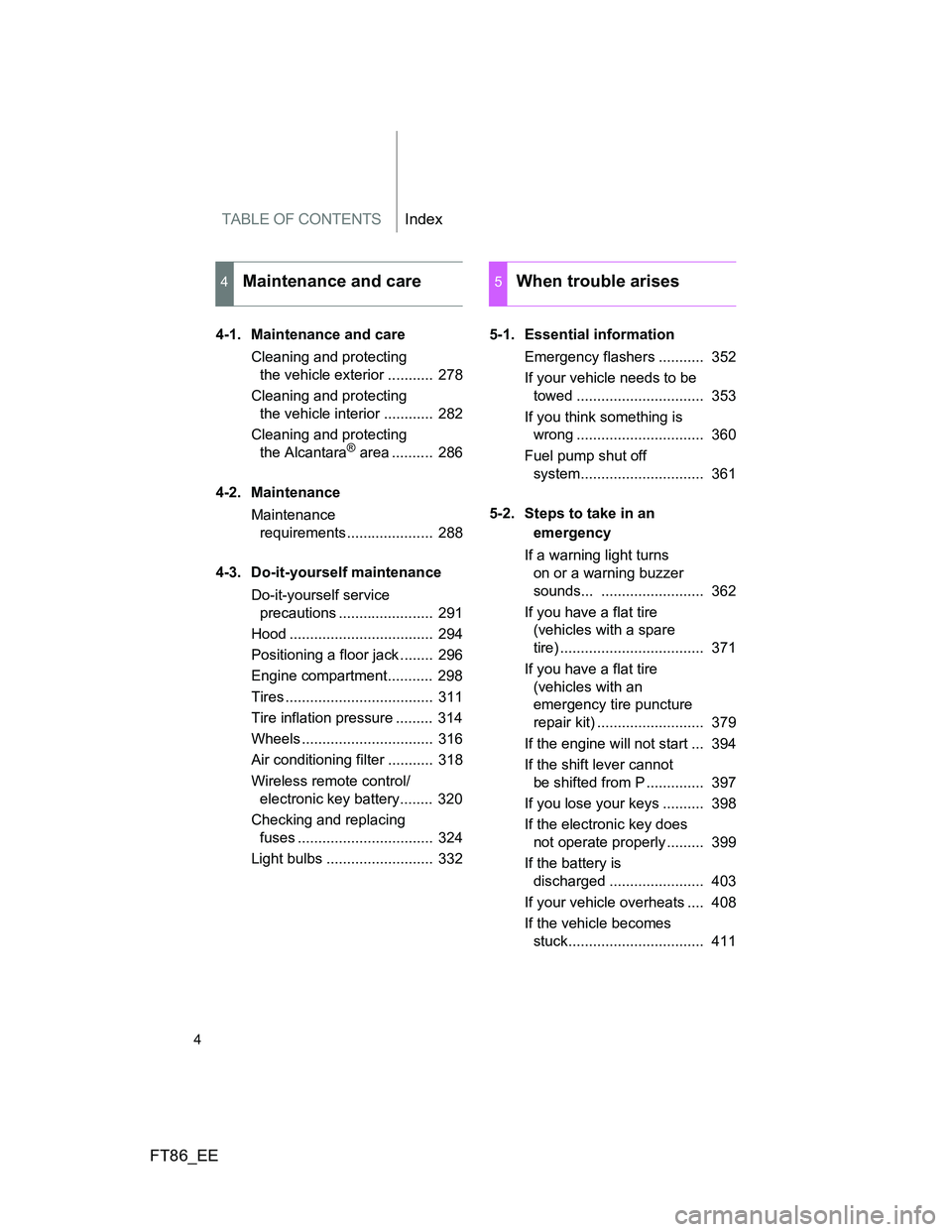
TABLE OF CONTENTSIndex
FT86_EE
4
4-1. Maintenance and care
Cleaning and protecting
the vehicle exterior ........... 278
Cleaning and protecting
the vehicle interior ............ 282
Cleaning and protecting
the Alcantara
® area .......... 286
4-2. Maintenance
Maintenance
requirements..................... 288
4-3. Do-it-yourself maintenance
Do-it-yourself service
precautions ....................... 291
Hood ................................... 294
Positioning a floor jack ........ 296
Engine compartment........... 298
Tires .................................... 311
Tire inflation pressure ......... 314
Wheels ................................ 316
Air conditioning filter ........... 318
Wireless remote control/
electronic key battery........ 320
Checking and replacing
fuses ................................. 324
Light bulbs .......................... 3325-1. Essential information
Emergency flashers ........... 352
If your vehicle needs to be
towed ............................... 353
If you think something is
wrong ............................... 360
Fuel pump shut off
system.............................. 361
5-2. Steps to take in an
emergency
If a warning light turns
on or a warning buzzer
sounds... ......................... 362
If you have a flat tire
(vehicles with a spare
tire) ................................... 371
If you have a flat tire
(vehicles with an
emergency tire puncture
repair kit) .......................... 379
If the engine will not start ... 394
If the shift lever cannot
be shifted from P .............. 397
If you lose your keys .......... 398
If the electronic key does
not operate properly ......... 399
If the battery is
discharged ....................... 403
If your vehicle overheats .... 408
If the vehicle becomes
stuck................................. 411
4Maintenance and care5When trouble arises
Page 7 of 448
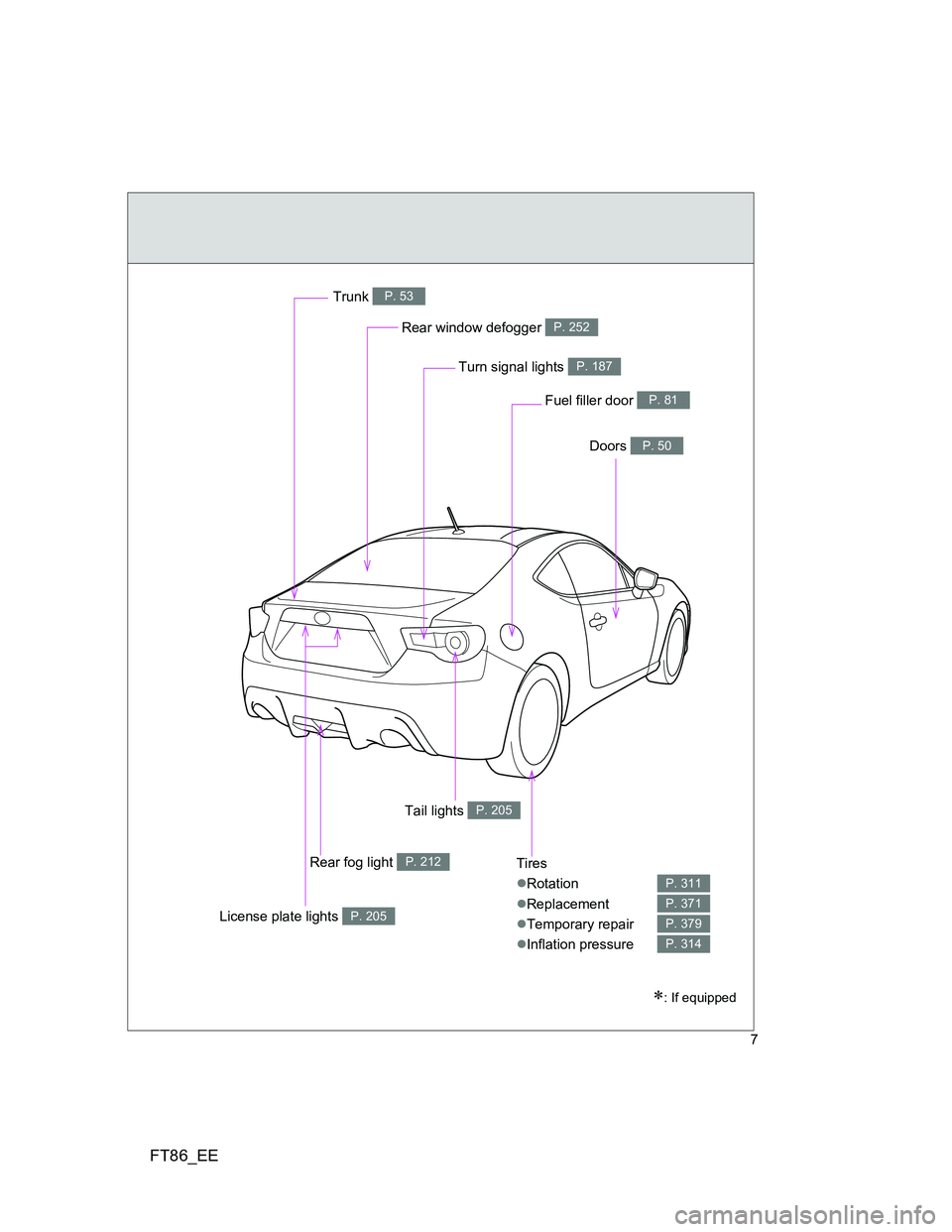
FT86_EE
7
Tires
Rotation
Replacement
Temporary repair
Inflation pressure
P. 311
P. 371
P. 379
P. 314
Rear window defogger P. 252
Trunk P. 53
Doors P. 50
Fuel filler door P. 81
Turn signal lights P. 187
: If equipped
License plate lights P. 205
Tail lights P. 205
Rear fog light P. 212
Page 154 of 448
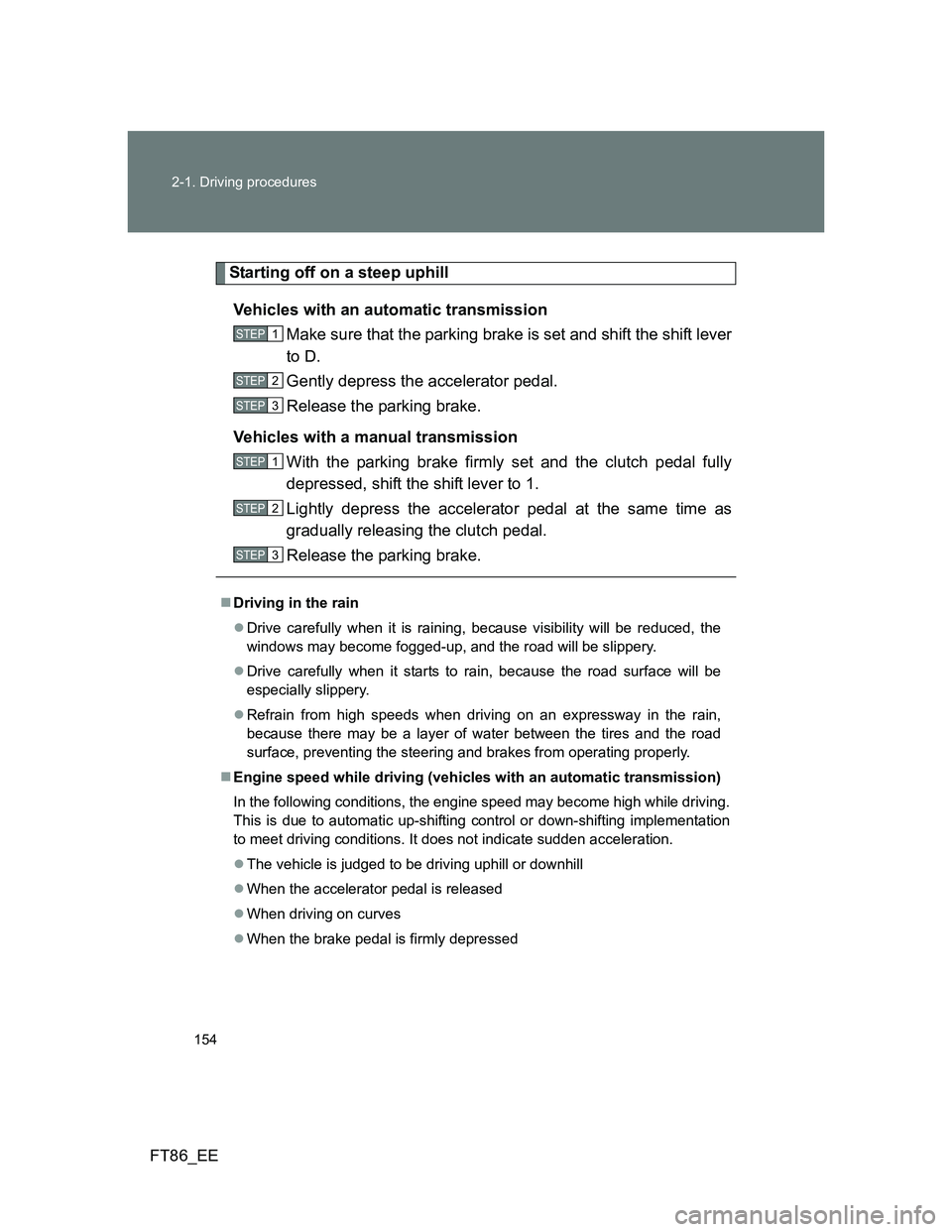
154 2-1. Driving procedures
FT86_EE
Starting off on a steep uphill
Vehicles with an automatic transmission
Make sure that the parking brake is set and shift the shift lever
to D.
Gently depress the accelerator pedal.
Release the parking brake.
Vehicles with a manual transmission
With the parking brake firmly set and the clutch pedal fully
depressed, shift the shift lever to 1.
Lightly depress the accelerator pedal at the same time as
gradually releasing the clutch pedal.
Release the parking brake.
Driving in the rain
Drive carefully when it is raining, because visibility will be reduced, the
windows may become fogged-up, and the road will be slippery.
Drive carefully when it starts to rain, because the road surface will be
especially slippery.
Refrain from high speeds when driving on an expressway in the rain,
because there may be a layer of water between the tires and the road
surface, preventing the steering and brakes from operating properly.
Engine speed while driving (vehicles with an automatic transmission)
In the following conditions, the engine speed may become high while driving.
This is due to automatic up-shifting control or down-shifting implementation
to meet driving conditions. It does not indicate sudden acceleration.
The vehicle is judged to be driving uphill or downhill
When the accelerator pedal is released
When driving on curves
When the brake pedal is firmly depressed
STEP 1
STEP 2
STEP 3
STEP 1
STEP 2
STEP 3
Page 225 of 448
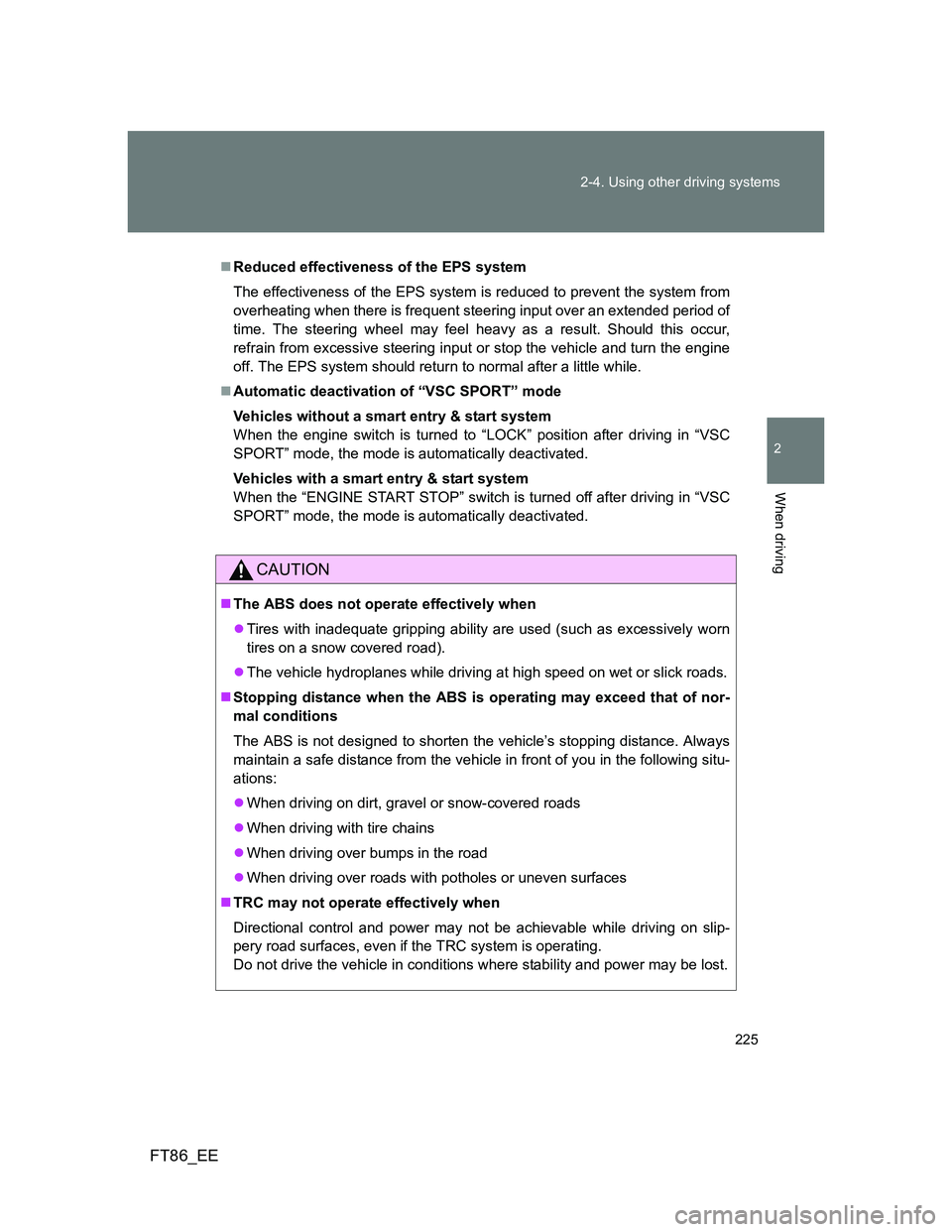
225 2-4. Using other driving systems
2
When driving
FT86_EE
Reduced effectiveness of the EPS system
The effectiveness of the EPS system is reduced to prevent the system from
overheating when there is frequent steering input over an extended period of
time. The steering wheel may feel heavy as a result. Should this occur,
refrain from excessive steering input or stop the vehicle and turn the engine
off. The EPS system should return to normal after a little while.
Automatic deactivation of “VSC SPORT” mode
Vehicles without a smart entry & start system
When the engine switch is turned to “LOCK” position after driving in “VSC
SPORT” mode, the mode is automatically deactivated.
Vehicles with a smart entry & start system
When the “ENGINE START STOP” switch is turned off after driving in “VSC
SPORT” mode, the mode is automatically deactivated.
CAUTION
The ABS does not operate effectively when
Tires with inadequate gripping ability are used (such as excessively worn
tires on a snow covered road).
The vehicle hydroplanes while driving at high speed on wet or slick roads.
Stopping distance when the ABS is operating may exceed that of nor-
mal conditions
The ABS is not designed to shorten the vehicle’s stopping distance. Always
maintain a safe distance from the vehicle in front of you in the following situ-
ations:
When driving on dirt, gravel or snow-covered roads
When driving with tire chains
When driving over bumps in the road
When driving over roads with potholes or uneven surfaces
TRC may not operate effectively when
Directional control and power may not be achievable while driving on slip-
pery road surfaces, even if the TRC system is operating.
Do not drive the vehicle in conditions where stability and power may be lost.
Page 226 of 448
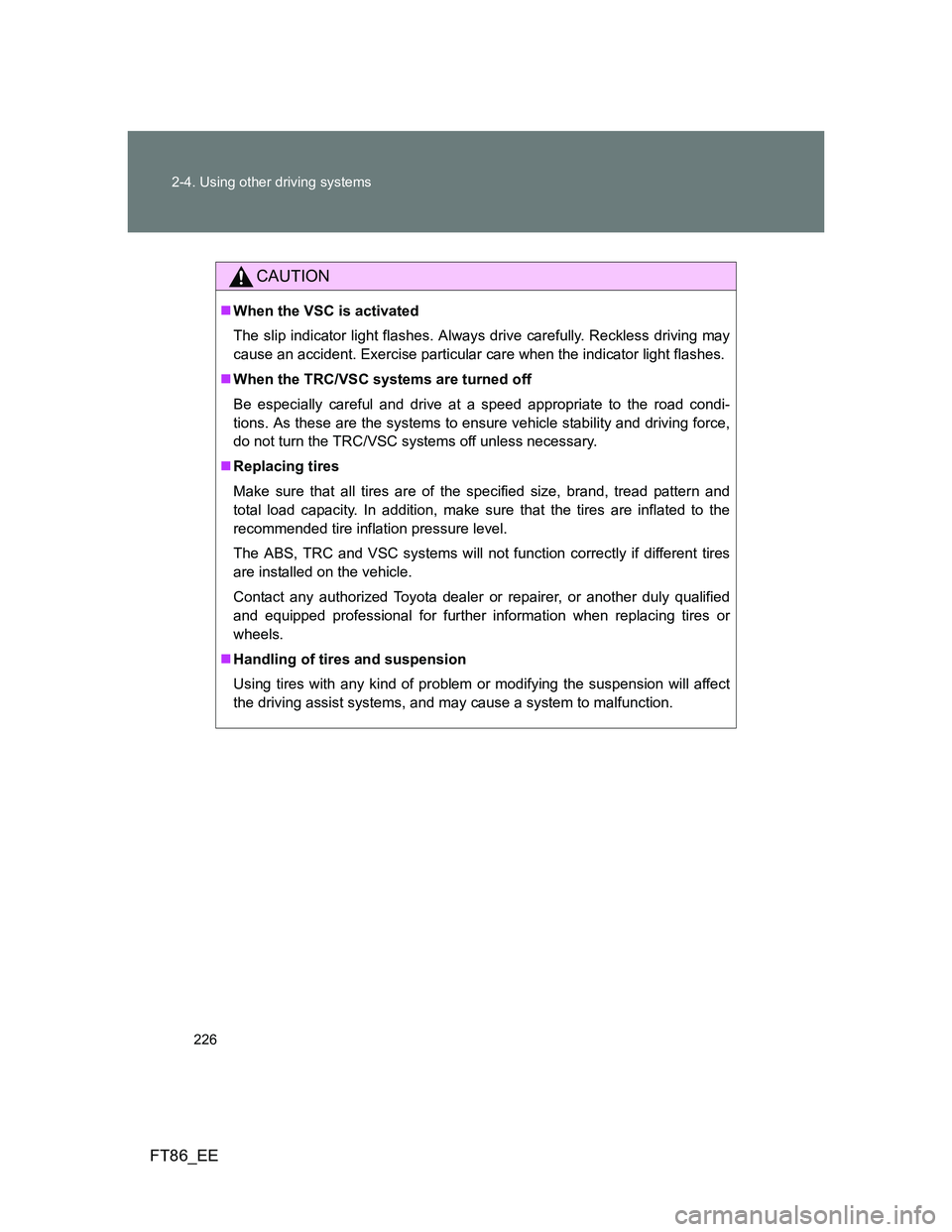
226 2-4. Using other driving systems
FT86_EE
CAUTION
When the VSC is activated
The slip indicator light flashes. Always drive carefully. Reckless driving may
cause an accident. Exercise particular care when the indicator light flashes.
When the TRC/VSC systems are turned off
Be especially careful and drive at a speed appropriate to the road condi-
tions. As these are the systems to ensure vehicle stability and driving force,
do not turn the TRC/VSC systems off unless necessary.
Replacing tires
Make sure that all tires are of the specified size, brand, tread pattern and
total load capacity. In addition, make sure that the tires are inflated to the
recommended tire inflation pressure level.
The ABS, TRC and VSC systems will not function correctly if different tires
are installed on the vehicle.
Contact any authorized Toyota dealer or repairer, or another duly qualified
and equipped professional for further information when replacing tires or
wheels.
Handling of tires and suspension
Using tires with any kind of problem or modifying the suspension will affect
the driving assist systems, and may cause a system to malfunction.
Page 229 of 448
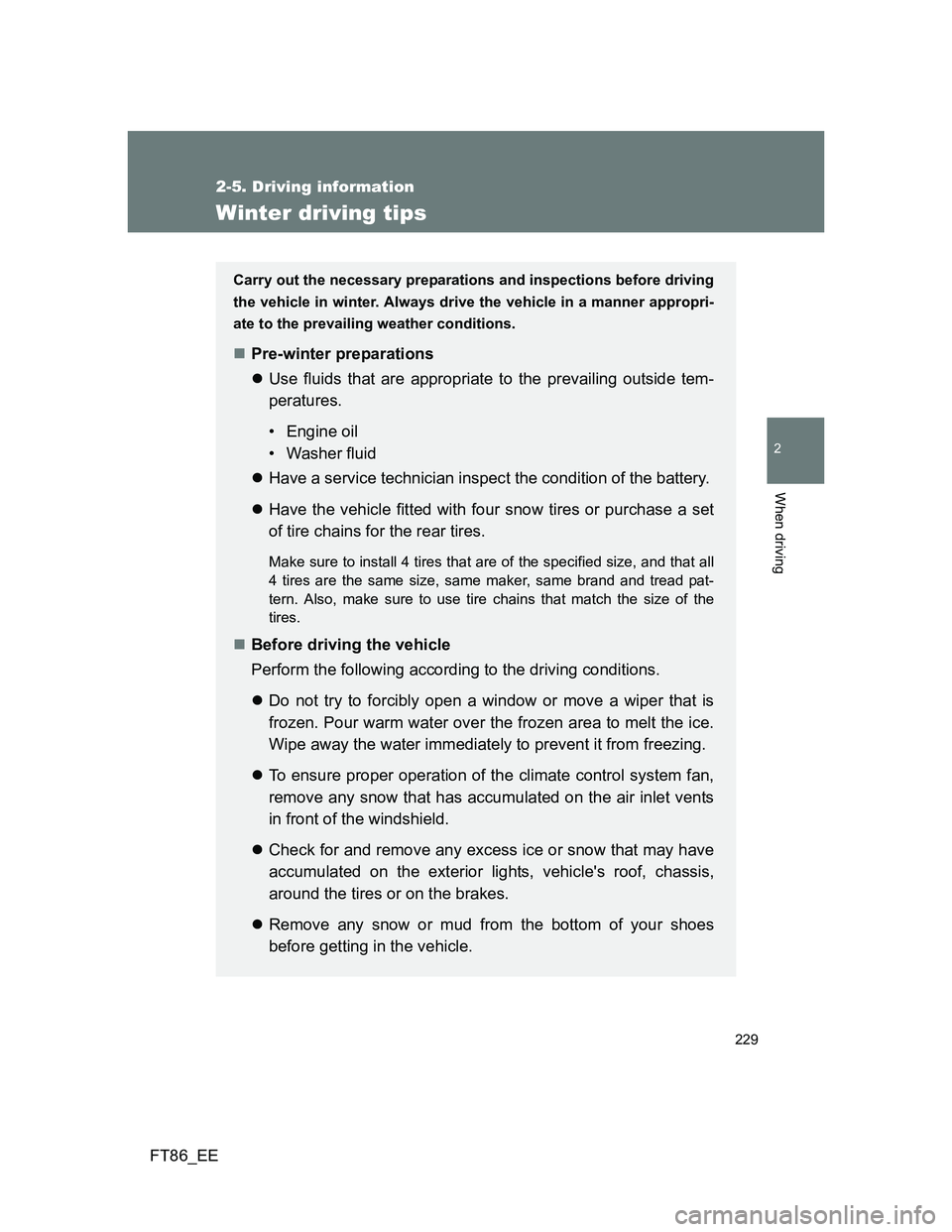
229
2-5. Driving information
2
When driving
FT86_EE
Winter driving tips
Carry out the necessary preparations and inspections before driving
the vehicle in winter. Always drive the vehicle in a manner appropri-
ate to the prevailing weather conditions.
Pre-winter preparations
Use fluids that are appropriate to the prevailing outside tem-
peratures.
• Engine oil
• Washer fluid
Have a service technician inspect the condition of the battery.
Have the vehicle fitted with four snow tires or purchase a set
of tire chains for the rear tires.
Make sure to install 4 tires that are of the specified size, and that all
4 tires are the same size, same maker, same brand and tread pat-
tern. Also, make sure to use tire chains that match the size of the
tires.
Before driving the vehicle
Perform the following according to the driving conditions.
Do not try to forcibly open a window or move a wiper that is
frozen. Pour warm water over the frozen area to melt the ice.
Wipe away the water immediately to prevent it from freezing.
To ensure proper operation of the climate control system fan,
remove any snow that has accumulated on the air inlet vents
in front of the windshield.
Check for and remove any excess ice or snow that may have
accumulated on the exterior lights, vehicle's roof, chassis,
around the tires or on the brakes.
Remove any snow or mud from the bottom of your shoes
before getting in the vehicle.
Page 231 of 448
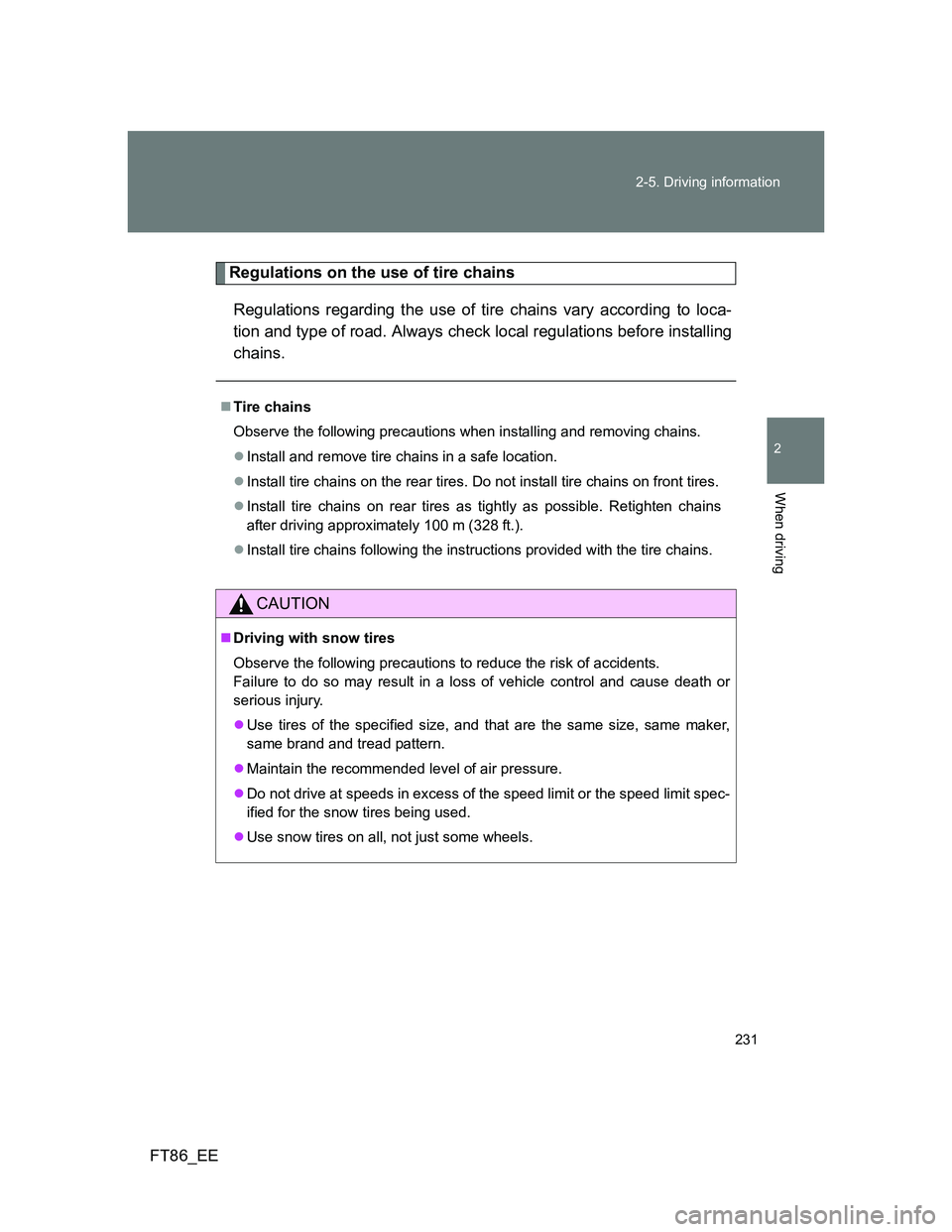
231 2-5. Driving information
2
When driving
FT86_EE
Regulations on the use of tire chains
Regulations regarding the use of tire chains vary according to loca-
tion and type of road. Always check local regulations before installing
chains.
Tire chains
Observe the following precautions when installing and removing chains.
Install and remove tire chains in a safe location.
Install tire chains on the rear tires. Do not install tire chains on front tires.
Install tire chains on rear tires as tightly as possible. Retighten chains
after driving approximately 100 m (328 ft.).
Install tire chains following the instructions provided with the tire chains.
CAUTION
Driving with snow tires
Observe the following precautions to reduce the risk of accidents.
Failure to do so may result in a loss of vehicle control and cause death or
serious injury.
Use tires of the specified size, and that are the same size, same maker,
same brand and tread pattern.
Maintain the recommended level of air pressure.
Do not drive at speeds in excess of the speed limit or the speed limit spec-
ified for the snow tires being used.
Use snow tires on all, not just some wheels.
Page 232 of 448
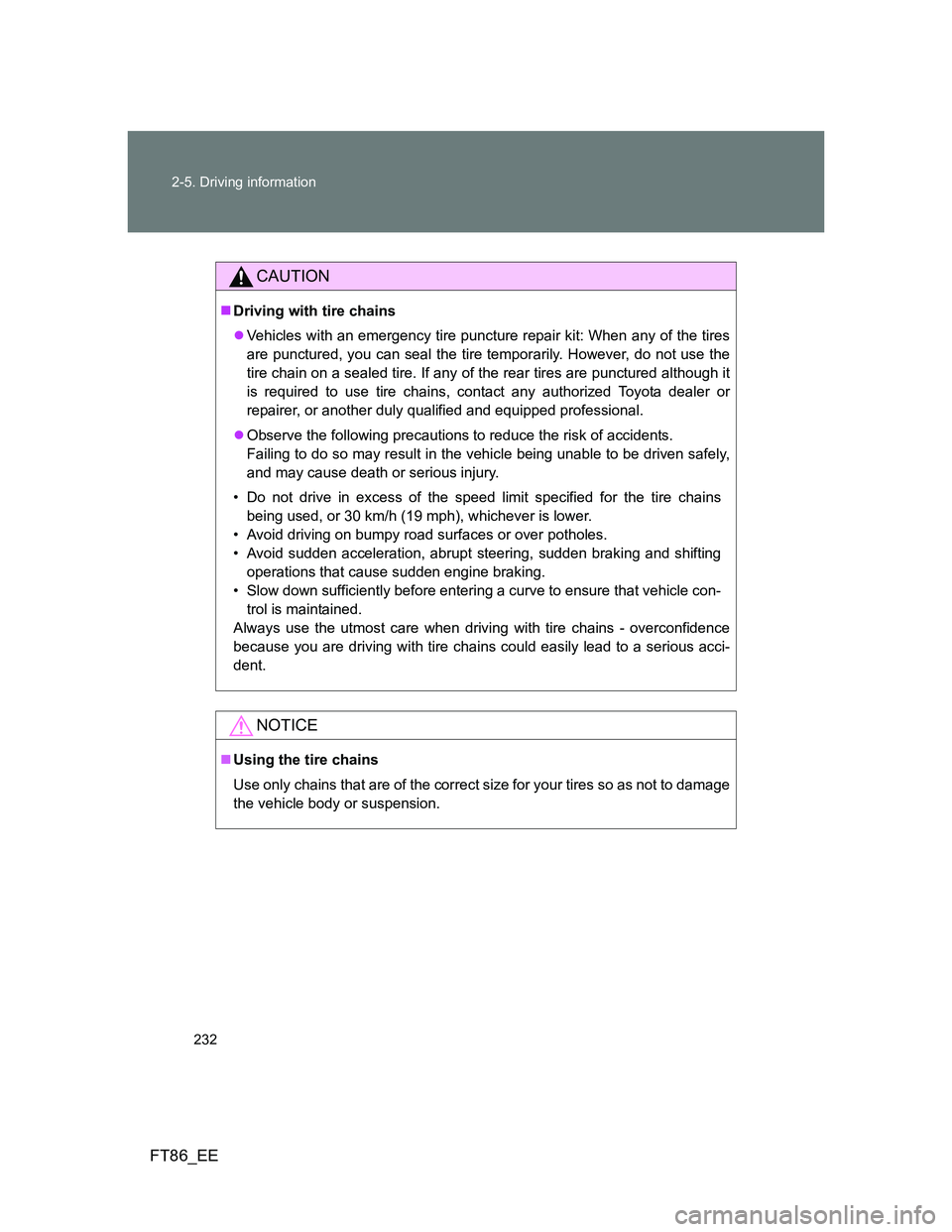
232 2-5. Driving information
FT86_EE
CAUTION
Driving with tire chains
Vehicles with an emergency tire puncture repair kit: When any of the tires
are punctured, you can seal the tire temporarily. However, do not use the
tire chain on a sealed tire. If any of the rear tires are punctured although it
is required to use tire chains, contact any authorized Toyota dealer or
repairer, or another duly qualified and equipped professional.
Observe the following precautions to reduce the risk of accidents.
Failing to do so may result in the vehicle being unable to be driven safely,
and may cause death or serious injury.
• Do not drive in excess of the speed limit specified for the tire chains
being used, or 30 km/h (19 mph), whichever is lower.
• Avoid driving on bumpy road surfaces or over potholes.
• Avoid sudden acceleration, abrupt steering, sudden braking and shifting
operations that cause sudden engine braking.
• Slow down sufficiently before entering a curve to ensure that vehicle con-
trol is maintained.
Always use the utmost care when driving with tire chains - overconfidence
because you are driving with tire chains could easily lead to a serious acci-
dent.
NOTICE
Using the tire chains
Use only chains that are of the correct size for your tires so as not to damage
the vehicle body or suspension.
Page 277 of 448

4Maintenance and care
277
FT86_EE
4-1. Maintenance and care
Cleaning and protecting
the vehicle exterior ......... 278
Cleaning and protecting
the vehicle interior .......... 282
Cleaning and protecting
the Alcantara
® area ........ 286
4-2. Maintenance
Maintenance
requirements................... 288
4-3. Do-it-yourself maintenance
Do-it-yourself service
precautions ..................... 291
Hood ................................. 294
Positioning a floor jack ...... 296
Engine compartment......... 298
Tires .................................. 311
Tire inflation pressure ....... 314
Wheels .............................. 316
Air conditioning filter ......... 318
Wireless remote control/
electronic key battery...... 320
Checking and replacing
fuses ............................... 324
Light bulbs ........................ 332
Page 289 of 448
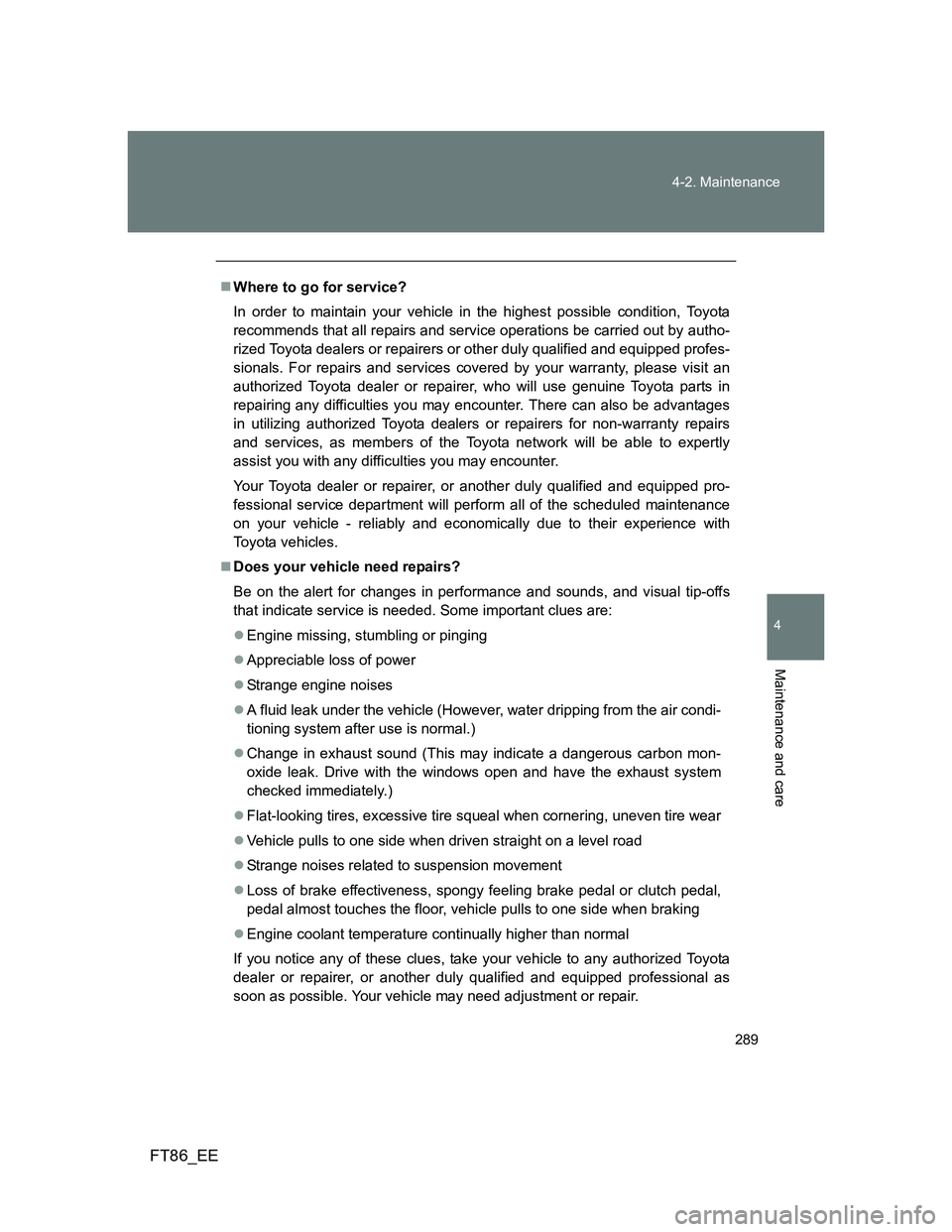
289 4-2. Maintenance
4
Maintenance and care
FT86_EE
Where to go for service?
In order to maintain your vehicle in the highest possible condition, Toyota
recommends that all repairs and service operations be carried out by autho-
rized Toyota dealers or repairers or other duly qualified and equipped profes-
sionals. For repairs and services covered by your warranty, please visit an
authorized Toyota dealer or repairer, who will use genuine Toyota parts in
repairing any difficulties you may encounter. There can also be advantages
in utilizing authorized Toyota dealers or repairers for non-warranty repairs
and services, as members of the Toyota network will be able to expertly
assist you with any difficulties you may encounter.
Your Toyota dealer or repairer, or another duly qualified and equipped pro-
fessional service department will perform all of the scheduled maintenance
on your vehicle - reliably and economically due to their experience with
Toyota vehicles.
Does your vehicle need repairs?
Be on the alert for changes in performance and sounds, and visual tip-offs
that indicate service is needed. Some important clues are:
Engine missing, stumbling or pinging
Appreciable loss of power
Strange engine noises
A fluid leak under the vehicle (However, water dripping from the air condi-
tioning system after use is normal.)
Change in exhaust sound (This may indicate a dangerous carbon mon-
oxide leak. Drive with the windows open and have the exhaust system
checked immediately.)
Flat-looking tires, excessive tire squeal when cornering, uneven tire wear
Vehicle pulls to one side when driven straight on a level road
Strange noises related to suspension movement
Loss of brake effectiveness, spongy feeling brake pedal or clutch pedal,
pedal almost touches the floor, vehicle pulls to one side when braking
Engine coolant temperature continually higher than normal
If you notice any of these clues, take your vehicle to any authorized Toyota
dealer or repairer, or another duly qualified and equipped professional as
soon as possible. Your vehicle may need adjustment or repair.